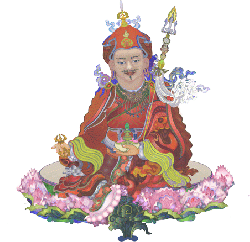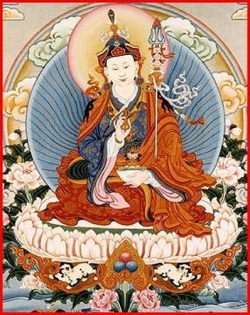Terma Transmission
Since the tenth century, Tibetan Buddhist traditions have recognized the discovery of concealed teachings – terma – as a profound and authentic form of transmission of the teachings. This mode of transmission is considered the “short” mode, as opposed to the “long” mode of the Kama, which has been transmitted person to person since the 8th century. Terma, in contrast, claims to be a direct transmission from Padmasambhava (or, less frequently, Vairocana or another 8th century master) and the treasure discover, bypassing the centuries inbetween.
The treasures are said to have been concealed by Padmasambhava to be discovered in the appropriate time. They are considered to be the condensed quintessence of the Kama, which contains the main teachings practiced at the time of Padmasambhava and upon which the termas are based.
According to the foundational legend, when Padmasambhava bestowed the ripening empowerments and liberating instructions upon the king Trisong Detsen (khri srong lde’u btsan), Yeshe Tsogyal and other of his twenty-five main disciples, he entrusted many teachings to each of them for later dissemination. With their assistance he then concealed these as treasures in various places – rocks, lake, temples, statues, and even in the sky and in the mindstream of the recipient. He then prophesied that, in the future, these disciples would reincarnate, reveal these teachings from their place of concealment and spread them for the sake of beings.
Those who reveal treasure are called tertons (gter ston). In due time, a terton is said to experience visions or signs indicating how and where to discover his or her destined terma. Often they experience a vision of a being who hands them an inventory of the treasures to be revealed, with the location.
A kind of treasure that is sometimes considered a third stream of transmission is dagnang (dag snang) or pure vision. As explained by Dilgo Khyentse Rinpoche, in pure visions the terton has a vision of Padmasambhava or another saint from the lineage who transmits the teaching. Two other primary methods of revelation, to be discussed below, are earth treasure (sa gter), which are physical objects revealed from actual places, and mind treasure (dgongs gter), which are extracted from the mind of the treasure revealer.
The terma teachings are considered powerful because they were not corrupted by the impurities that inevitably occurred in the history of lineages and are particularly relevant for the time of their prophesized discovery. That is, as direct transmissions from Padmasambhava or other Imperial-era saints, they did not suffer from scribal errors or innovations introduced by lineage holders over the centuries.
There are customarily three ways by which Padmasambhava set forth a teaching as a treasure:
1) By giving a prediction: Padmasambhava predicted that the benefit of these teachings for sentient beings will be accomplished by a certain disciple and that the terma will be revealed at a certain appropriate time, place, and circumstance.
2) By means of an empowerment through wishing prayers: While focusing his wisdom mind, Padmasambhava prayed that the teachings and pith instructions given at the time of bestowing the empowerment may fully and clearly arise in the mind of the disciple in the rebirth during which he or she is meant to reveal the treasure. The disciples also prayed in the same way. This is why almost all Nyingma termas were revealed by incarnations of directs disciples of Padmasambhava, the main ones being known as the “Twenty-five, The Lord and Subjects” or jebang nyernga (rje ’bangs nyer lnga).
3) By entrusting the dakinis to look after the terma: Padmasambhava put the dakinis in charge of ensuring that, in due time, the terton will find the treasure, will be able to transmit it to suitable disciples, and that his lineage will carry great blessings while being kept secret from unqualified disciples.
The terma teaching is said to have then been placed under the guardianship of a specific protector, referred to as a Terma Protector (gter srung), who will only allow the right person to be given access to the treasure. One some occasions, however, a terton may bless another realized master to extract the treasure in his place. This is how, for instance, Jedrung Trinle Jampa Jungne (rje drung phrin las byams pa ’byung gnas) of Riwoche (ri bo ches) asked the famed yogi Gara Lama (mgar ra bla ma), in front of a large crowd, to retrieve a terma on Amitayus, the Buddha of Infinite Life.
Out of these three aspects of the transmission, the wishing prayer of Padmasambhava is considered to be the most important, as it is the means by which the entire process unfolds. In fact, it is sometimes said that whichever form the terma is found, such as dakini symbolic scripts written on a yellow parchment (shog ser), this is said to be a mere support for remembering the time when the terton received the teachings from Padmasambhava. The real transmission is said to have been given from mind to mind given by Padmasambhava.
On the basis of this symbolic support, the terton with proper karma will thus be able to “establish” (brtan la ’bab) the whole teachings, sometimes in the flash of an instant, and put it in writing without any of the hesitations and discursive thinking that normally characterize ordinary literary compositions. It is said that the terton may see the whole text “as if looking into a mirror.” It is explained that the sight of the dakini scripts acts as a trigger so that the teachings arise effortlessly from the creative power of the vast expanse of pure awareness.
Some termas arise in ways that are clearly and beautifully written, complete and in perfect order, such as the Prayer in Seven Chapters revealed by Rigdzin Godemchen (rig ’dzin rgod ldem chen), some in a seemingly disordered and obscure style that requires it to be rearranged and clarified, for instance some of the termas revealed by Rigdzin Longsel Nyingpo (rig ’dzin klong gsal snying po). This is why, in addition to the root terma, a great master in the terton’s lineage usually needs to prepare a text which incorporates the terma teachings but is arranged in the form of a “means of accomplishment” or sadhana, or a ritual text that can readily be used by practitioners.


